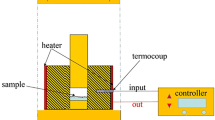Abstract
The conditions of Bi2Ti4O11 formation are studied. It is shown that the process is diffusion-controlled and depends significantly on the heating rate. The optimal conditions for producing Bi2Ti4O11 ceramics are determined. Cold pressing of Bi2Ti4O11 ceramic powder at high pressures is shown to influence the unit-cell parameters and volume, positional parameters of Bi and Ti, and bond distances in the ferroelectric ceramics produced by subsequent sintering. The ferroelectric transition temperature decreases steadily with increasing densification pressure.
Similar content being viewed by others
REFERENCES
Koichi Fukuda, Ryozo Kiton, and Ikuo Awai, Micro-wave Characteristics of Bi 2 O 3 –TiO 2 Dielectric Resonator, Jpn.J.Appl.Phys., 1993, vol. 32, pp. 4584–4588.
Speranskaya, E.I., Rez, I.S., Kozlova, L.V., et al., Bismuth Oxide–Titanium Dioxide System, Izv.Akad.Nauk SSSR, Neorg.Mater, 1965, vol. 1, no. 2, pp. 232–235.
Belyaev, I.N., Smolyaninov, N.P., and Kal'nitskii, N.R., System Bi 2 O 3 –TiO 2 –PbO, Zh.Neorg.Khim., 1963, vol. 8, no. 2, pp. 384–388.
Hrovat, M., Holc, J., and Kolar, D., Phase Equilibria in RuO 2 –TiO 2 –Al 2 O 3 and RuO 2 –TiO 2 –Bi 2 O 3, J.Mater.Sci.Lett., 1993, vol. 12, pp. 1858–1860.
Diagrammy sostoyaniya sistem tugoplavkikh oksidov: Spravochnik (Phase Diagrams of Refractory Oxide Sys-tems: A Handbook), part 2: Dvoinye sistemy (Binary Systems), Leningrad: Nauka, 1986, issue 5.
Kahlenberg, V. and Böhm, H., The Structure of α-and β-Bi 2 Ti 4 O 11, Acta Crystallogr., Sect.B: Struct.Sci., 1995, vol. 51, pp. 11–18.
Cheremskoi, P.G., Metody issledovaniya poristosti tver-dykh tel (Techniques for Assessing Porosity in Solids), Moscow: Energoizdat, 1985.
Dzhafarov, T.D., Altunbas, M., and Gorur, O., The High-Temperature Thermal Expansion of BiPbSrCaCuO Superconductors and the Oxide Component (Bi 2 O 3, PbO, CaO, CuO), J.Mater.Sci., 1996, vol. 31, pp. 2207-2212.
Hua, Z.-Z., Kimura, T., and Yamaguchi, T., Formation of Bi 4 Ti 3 O 12 from Bi 2 O 3 –TiO 2 Mixtures, J.Ceram.Soc.Jpn., 1983, vol. 91, pp. 420–423.
Kahlenberg, V. and Böhm, H., On the Existence of a Pyrochlore-Type Phase in the System Bi 2 O 3 –TiO 2, Cryst.Res.Technol., 1995, vol. 30, pp. 237–241.
Sestak, I., Thermal Analysis (6, ICTA), Stuttgart: Birkhauser, 1980, vol. 1, p. 29.
Rietveld, H.M., Profile Refinement Method for Nuclear and Magnetic Structures, J.Appl.Crystallogr., 1969, vol. 2, pp. 65–69.
Author information
Authors and Affiliations
Rights and permissions
About this article
Cite this article
Akimov, A.I., Savchuk, G.K. Synthesis and Sintering of Bi2Ti4O11 . Inorganic Materials 40, 716–720 (2004). https://doi.org/10.1023/B:INMA.0000034770.04111.12
Issue Date:
DOI: https://doi.org/10.1023/B:INMA.0000034770.04111.12




